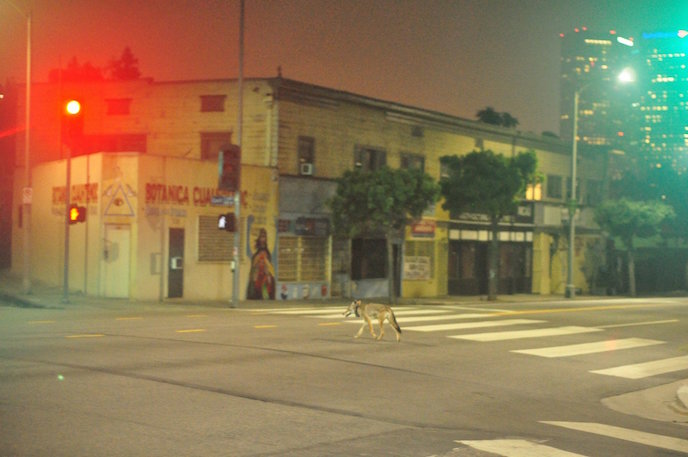Scientists Begin Tracking LA River Coyote
- Details
- Written by NPS
- Category: California News
Santa Monica, California - As part of their recent efforts to better understand how coyotes survive in extremely urbanized areas, National Park Service researchers recently began tracking a coyote in Northeast Los Angeles near the LA River.
The young female, approximately seven to nine months old, is now known as C-146 because she is the 146th coyote tracked as part of the National Park Service study, though only the third in urban core of Los Angeles. She was captured early on the morning of September 23, outfitted with a GPS collar, and then released in the same location.
"We're very interested to learn how this animal is using the Los Angeles River," said Justin Brown, biologist with Santa Monica Mountains National Recreation Area. "So far all of her recorded GPS locations have been confined to a two mile or so stretch on both sides of the river.
"
"
Coyote C144 prior to losing the signal emanating from
his GPS collar
C-146's GPS collar is programmed to record an average of eight GPS locations over a 24-hour period.
his GPS collar
C-146's GPS collar is programmed to record an average of eight GPS locations over a 24-hour period.
Brown believes C-146 is from a pack of at least five individuals, three juveniles and two adults, that was captured on camera together in early September. As a juvenile, she will provide insight into how long the juveniles in this area stay with their parents and what routes young animals may take to disperse and find their own territories.
Although National Park Service researchers studied coyotes from 1996 to 2004 in parts of Los Angeles and Ventura counties, they only began studying urban Los Angeles coyotes in May.
As for the other two animals in the pilot project, researchers continue to track the Silver Lake coyote known as C-145, but the battery in C-144's collar recently failed. C-144, who spent most of her time just west of downtown Los Angeles, is believed to have one of the most urban home ranges of any coyote ever studied and had recently made some interesting movements to the west.
Read about what researchers learned about C-144 before her collar failed on Gridlocked, the urban wildlife blog of Santa Monica Mountains National Recreation Area.
Coyotes are medium-sized canids that inhabit most of North America. Coyotes in Southern California are often the subject of negative media attention, but serious coyote conflicts with humans are rare. In order to reduce the likelihood of a negative interaction with a coyote, residents should be careful not to feed wildlife, either intentionally or unintentionally.
Learn more about co-existing with coyotes atnps.gov/samo/learn/management/coyotes.htm.
Santa Monica Mountains National Recreation Area (SMMNRA) is the largest urban national park in the country, encompassing more than 150,000 acres of mountains and coastline in Ventura and Los Angeles counties. A unit of the National Park Service, it comprises a seamless network of local, state and federal parks interwoven with private lands and communities. As one of only five Mediterranean ecosystems in the world, SMMNRA preserves the rich biological diversity of more than 450 animal species and 26 distinct plant communities. For more information, visit nps.gov/samo.
-------------------------------------------------------------------------------------------------------------------------------------------
http://www.nps.gov/samo/blogs/What-We-Learned-Before-C-144-s-Collar-Died.htm
What We Learned Before C-144’s Collar Died
Technology giveth and it taketh away. For nearly five months, the GPS collar worn by the coyote known as C-144 provided rich and accurate location data that shed light onone of the most urban coyotes ever studied.
And then the battery died. Right when it was getting really interesting.
After spending most of her time in the Westlake neighborhood just west of downtown Los Angeles, with occasional forays across the 101 Freeway into Echo Park, C-144 suddenly left her home range and headed west. Her jaunt included traveling through Koreatown, East Hollywood, Larchmont, Windsor Square, and Hancock Park. She returned after just a few days, but the battery in her collar died shortly thereafter
, C-144’s recorded GPS locations from May to late September 2015.
C-144 spent most of her time in the Westlake neighborhood just west of
downtown LA. | Image: National Park Service.
“It’s highly unusual for an alpha female to leave her home range like this,” said Justin Brown, a biologist with Santa Monica Mountains National Recreation Area. “We’d really like to understand why she left her territory, but unfortunately without a working collar we probably will never know.”
Although Brown is unsure why C-144 would move to the west, it’s possible it could have been related to the loss of a mate, a change in the availability of a food source, or an attempt to help pups establish their own territory once they disperse.
Because coyotes are difficult to re-capture and there are limited locations available to capture her in her home range, Brown is doubtful that he’ll be able to replace her collar. He hopes to capture one of her pack mates in the near future in order to better understand pack dynamics, such as whether the pack will stay together and what happens to young animals that need to find their own home range in heavily urbanized areas.
C-144 crosses a Los Angeles street in the early hours of the morning
. | Photo: National Park Service

Still, C-144 (and her GPS collar) gave us a glimpse of something incredible: a top predator surviving and caring for her pups in a densely populated area with very little natural habitat -- not occasionally visiting from a more natural area, but actually persisting entirely within the confines of an extremely urbanized habitat.
We’re grateful for the GPS technology that gave us a peek into her fascinating life and extremely disappointed about the battery that died far too soon.
C-144 crosses a Los Angeles street in the early hours of the morning. | Photo: National Park Service



No comments:
Post a Comment